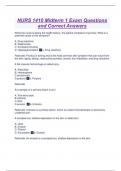NURS 1410 Midterm 1 Exam Questions
and Correct Answers
While the nurse is taking the health history, the patient complains of pruritus. What is a
potential cause of this symptom?
A. Drug reactions
B. Diaphoresis
C. Excessive bruising
D. Hyperpigmentation ✅a. Drug reactions
Rationale: Pruritus is itching and is the most common skin symptom that can result from
dry skin, aging, allergy, obstructive jaundice, uremia, lice infestation, and drug reactions.
A flat macular hemorrhage is called a(n)>
A. Petechiae
B. Hemangioma
C.ecchymosis
D.purpura ✅d. Purpura
Rationale
An example of a primary lesion is a(n)
A. Port-wine stain.
B.urticaria.
C.ulcer.
D.erosion. ✅b. Urticaria
Rationale: Urticaria is a primary lesion, which is a lesion that develops on previously
unaltered skin.
A scooped-out, shallow depression in the skin is called a(n)
A. Ulcer
B. Erosion
C. Fissure
D. Excoriation ✅b. Erosion
Rationale: An erosion is a scooped-out, shallow depression in the skin.
,A nursing student has been assigned to teach grade 4 students about the importance of
caring for their skin. Which of the following should be included while discussing the
skin?
A. The skin is a first line of defense to protect you against microorganisms and injury.
B.The skin is not part of regulating temperature.
C. The skin is the body's second largest organ system.
D. The skin is not waterproof. ✅a. The skin is a first line of defense to protect you
against microorganisms and injury.
Rationale: The skin is the first line of defense to protect the body against
microorganisms and injury. The skin is the sentry that guards the body from
environmental stresses (trauma, pathogens, dirt) and adapts it to the other
environmental influences (heat, cold).
Functions of the skin include
A. Temperature regulation
B. Secretion of a drying substance called sebum
C. The production of new cells by melanocytes
D. Production of vitamin c ✅a. Temperature regulation
Rationale: Functions of the skin include protection, prevention of penetration, perception
(of touch, pain, temperature, and pressure), temperature regulation, identification,
communication, wound repair, absorption and excretion, and production of vitamin D.
A 75-year-old hospitalized patient with limited mobility, activity, and nutrition scores a 7
on the Braden Risk Assessment Scale. What does this indicate?
A. The patient has pain that is greater than moderate in severity.
B. The patient has severe cognitive impairment.
C.The patient is at very high risk for skin tears, skin breakdown, and/or the development
of pressure sores.
D. The patient is at risk for malignant melanoma. ✅C. The patient is at very high risk
for skin tears, skin breakdown, and/or the development of pressure sores.
Rationale: The Braden Scale for Predicting Pressure Sore Risk assesses for the factors
of sensory perception, moisture, activity, mobility, nutrition, and friction and shear to
determine a patient's risk for skin breakdown and the development of pressure sores.
Compromised sensory perception and ability to respond to discomfort, increased skin
,exposure to moisture, decreased physical activity, decreased ability to mobilize, poor
food intake, and increased need for assistance to move are all contributing factors to
skin breakdown.
Which of the following terms refers to a linear skin lesion that runs along a nerve route?
A. Shinges
B. Polycyclic
C. Annular
D. Zosteriform ✅d. Zosteriform
Rationale: Zosteriform describes a lesion that has a linear arrangement along a nerve
root.
The components of a nail examination include
A. Colour, texture, distribution, and lesions.
B. Colour, texture, temperature, and moisture.
C. Shape, contour, consistency, and colour.
D.clubbing, pitting, and grooving. ✅c. Shape, contour, consistency, and colour.
Rationale: The nails are assessed for shape and contour, consistency, and colour
during inspection and palpation to acquire objective data.
To determine if a dark-skinned patient is pale, the nurse should assess the colour of the
A. Skin in the antecubital space.
B. Ear lobes
C. Conjuctivae
D. Elbows ✅c. Conjunctivae
Rationale: To detect pallor in a dark-skinned individual, the nurse should assess an
area with the least pigmentation, such as the conjunctivae or the mucous membranes.
What type of database is most appropriate when rapid collection of data is required and
often performed concurrently with life-saving measures?
A. Episodic
B. Emergency
C. Complete
D. Follow-up ✅b. Emergency
Rationale: An emergency database is rapid collection of the data often performed
concurrently with life-saving measures.
According to the biomedical model, a narrow definition of health is
, A. The response of the whole person to actual or potential problems.
B. Optimal functioning of mind, body, and spirit within the environment.
C. The absence of disease.
D. Prevention of disease. ✅c. The absence of disease.
Rationale: From a biomedical perspective, health is defined as the absence of disease
or elimination of symptoms and signs of disease.
A medical diagnosis is used to evaluate
A. The cause of disease.
B. A person's state of health.
C. The response of the whole person to actual or potential health problems.
D. A person's culture. ✅a the cause of disease
Rationale: Medical diagnoses are used to explain the etiology (cause) of disease.
Which of the following is considered an example of subjective data?
A. Left knee has been swollen and hot for the past 3 days
B. Crepitation in the left knee joint
C. Decreased range of motion
D. Arthritis ✅a. Left knee has been swollen and hot for the past 3 days
Rationale: Subjective data are what the person says about himself or herself during
history taking.
What type of database is most appropriate for an individual who is admitted to a long-
term care facility?
A. Episodic
B. Complete
C. Follow-up
D. Emergency ✅b. Complete
Rationale: A complete database includes a complete health history and a full physical
examination; it describes the current and past health state, and forms a baseline against
which all future changes can be measured.
Follow-up
Which of the following is considered an example of objective data?
A. Alert and oriented
B. Dizziness
C. An earache
D. A sore throat ✅a. Alert and oriented




